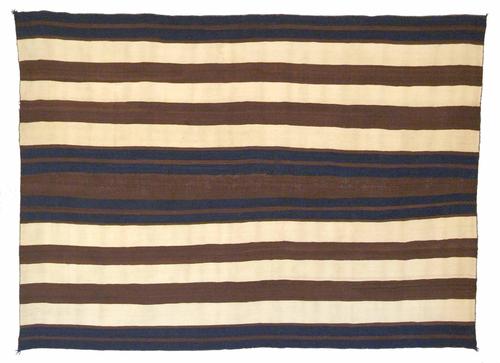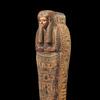New Textile Exhibitions Await Visitors to the Expanded Art Museums of Colonial Williamsburg in Summer 2021
- WILLIAMSBURG, Virginia
- /
- June 28, 2021

Visitors to the Abby Aldrich Rockefeller Folk Art Museum, one of the two expanded Art Museums of Colonial Williamsburg in Williamsburg, Virginia, will experience two new textile exhibitions opening in summer 2021: The Art of the Quilter will open on July 3 in the Foster and Muriel McCarl Gallery and Navajo Weavings: Adapting Tradition will open in the Mary B. and William Lehman Guyton Gallery in early August. These exhibitions are certain to be popular with museum goers as exhibitions displaying Colonial Williamsburg’s renowned quilt collection have always been favorites of Art Museums guests, and Navajo Weavings: Tradition and Trade, the first exhibition at Colonial Williamsburg on loan from the collection of American folk art enthusiasts Pat and Rex Lucke, has been embraced by visitors since it opened in 2018.
“Colonial Williamsburg’s curators have worked diligently over the last twenty years to ensure that our collections represent the diversity of the American people,” said Ronald L. Hurst, the institution’s Carlisle H. Humelsine Chief Curator and vice president for museums, preservation, and historic resources. “That critical work is ongoing, and these two exhibitions are clear evidence of our determination to use remarkable objects in telling a more complete and fulsome story.”
The Art of the Quilter will delight quilt aficionados new and old. A three-year exhibition that will rotate a selection of bed quilts from the early nineteenth-century to present day, it will feature twelve examples each year from Colonial Williamsburg’s superlative collection. Most of the quilts to be on display have never been shown before and many are recent acquisitions. The quilts tell stories about people from America’s past and the societies in which they lived; some bedcovers in the exhibition recalled milestone events in the lives of the makers, such as marriages, births or deaths. Others, such as album quilts, were created as reminders of friends and family left behind after a move that documented an increasingly mobile society in the nineteenth century as people moved westward to new lands and opportunities. Further stories are expressed through the motifs on the bedcovers. These extraordinary examples of handwork also demonstrate America’s multicultural society and include objects from the Anglo-American, African American, German, Amish, and Mennonite communities. The Art of the Quilter will remain on view through July 2024.

“We are literally ‘covering’ America with this exhibition!” said Kimberly Smith Ivey, Colonial Williamsburg’s senior curator of textiles. “The bed quilts display a variety of techniques, colors and materials and demonstrate the diversity of American society.”
Among the featured quilts to be seen when the exhibition opens are a pieced honeycomb quilt made of plain and printed cottons by Sarah Winifred Cobb (1842-1917) and Rachel, ca. 1850. This pieced quilt in a pattern often referred to as “Grandmother’s Flower Garden” is the product of both White and Black hands. A hand-written label once attached to the quilt reveals that eight-year-old Sarah Winifred Cobb, under the direction of the enslaved Rachel, pieced the quilt top. Apparently, young Sarah was much devoted to Rachel who presided over the nursery for two generations at the family home “Cobb Hill” in Richmond, Kentucky. Although Sarah and her family are well identified, nothing more is known about Rachel, not even her surname.
Another highlight of The Art of the Quilter is a show quilt made of silks with silk embroidery thread, attributed to Jane Ault and probably made in Pennsylvania or Ohio, ca. 1900. Constructed of rich-colored silk solids, plaids, textured weaves, and velvets, this small throw has the additional embellishment of feather stitches. Quiltmakers in the late nineteenth century often used silks edged with fancy stitches to create wildly asymmetrical pieced crazy quilts. In this example, the design is more organized and symmetrical than that of crazy quilts; it consists of 323 pieced blocks of a repeating pattern of scalloped squares on point within a square. The last owner recalls that the quilt was given to her mother by her great-aunt, Jane Ault.
Due to the popularity of Navajo Weavings: Tradition and Trade, the first Native American textiles exhibition at the Art Museums, the Luckes have generously loaned six more weavings to be shown in a new exhibition, Navajo Weavings: Adapting Tradition, none of which have been displayed at Colonial Williamsburg before. This exhibition will remain on view through December 2022. A longstanding cultural and artistic tradition passed down for generations, anonymous Navajo women created brilliantly colored, boldly designed pictorial blankets and rugs on hand looms. They adapted and modified their weavings from the world around them, creating an art form that is uniquely theirs and providing insight into the Navajo culture at the end of the 19th century. Through the woven motifs of these textiles, museum guests can learn what was important to the makers among the Diné (the term the Navajo use to refer to themselves meaning “the People”) and gain a sense of their aspirations.

The earliest of Navajo weavings were blankets to be worn, known as “chief blankets,” made with a simple, horizontally striped and banded design and format. A highlight of Navajo Weavings: Adapting Tradition is an extremely rare Classic Period chief’s blanket. While it remains difficult to closely date objects such as this, as the techniques, materials and design was consistent across the Navajo lands for many years, it is believed that this example was made between 1840 and 1860. Its earliest provenance dates to a Ute (Chief Ouray) who obtained the blanket from the Governor of Pueblo de Taos during the 1870s. Because these blankets were utilitarian, many did not survive; it is believed that only approximately 50 to 60 of the early classic Ute design blankets exist and many are in museums. This piece is woven from single-ply, handspun Churro wool; its white and brown colors are natural and the blue is from an indigo dye.
“The six Navajo weavings spanning about one hundred years highlight how the highly skilled Navajo weavers adapted and modified their traditional textiles from the world around them to meet the demands of a modern market and trade. With bold designs and brilliant colors, simple everyday objects like trains, livestock, and soda bottles were transformed into works of woven art, and today tell a compelling story of adaptation, survival, and change by the Navajo People,” said Ms. Ivey.
Although the American flag was favored by customers to whom the Diné sold their handwork, it rarely appears as a true rendering on Navajo weavings. As flags were displayed on government buildings, both the buildings themselves as well as the flags became symbolic of U.S. power and authority on Navajo land. The weavers, therefore, would have adapted the flag to suit their needs, sometimes altering the rectangular shape, changing the number of stars or substituting them with flowers or anchors to create an entirely different motif. Another of the weavings to be featured in this exhibition is American Flag made between 1900 and 1910 of Germantown yarns, aniline dye, and natural white wool. The high-quality woolen yarn imported by railroad from Germantown, Pennsylvania, for use in Navajo weavings was commercially spun and dyed in bright colors with synthetic dyes. Because of the cost, traders supplied the Germantown yarn to the most skilled and talented weavers resulting in some very remarkable weavings.
The Art of the Quilter was generously funded by the June G. Horsman Family Trust, and Navajo Weavings: Adapting Tradition received funding from donors who wish to remain anonymous.
For anyone who has ever made their own weaving or quilt, loves the history and tradition that these historic objects represent or simply appreciates hand-made textiles, The Art of the Quilter and Navajo Weavings: Adapting Tradition are must-see exhibitions.
Following the strictest safety protocols last summer, the Art Museums welcomed visitors to its expanded building, which also includes the DeWitt Wallace Decorative Arts Museum. The new complex includes an additional 25 percent of gallery spaces; over the past year more of the Foundation’s world-class collections are now on view and numerous additional amenities are available. Visitors and supporters of the Art Museums can take advantage of a new membership initiative that was announced in 2020 as well. Among many benefits of an Art Museums membership are unlimited admission to both museums for one year from date of purchase, a 25-percent discount on Art Museums single-day tickets for friends and family, a 10-percent discount on food and beverage at the new Museum Café, a 10-percent discount on purchases at the new Art Museums store, invitation to four members-only events per year, customized quarterly e-newsletters, discounts on four tickets per year to select program at the Hennage Auditorium, free parking in the Art Museums parking lot or at the Visitor Center as well as complimentary use of Colonial Williamsburg's shuttle service. Additional information about memberships can be found at https://www.colonialwilliamsburg.org/tickets/art-museums-membership/.
Additional information about the Art Museums and Colonial Williamsburg as well as tickets are available online at colonialwilliamsburg.org, by calling (855) 296-6627 and by following Colonial Williamsburg on Facebook and @colonialwmsburg on Twitter and Instagram.
About the Art Museums of Colonial Williamsburg
The Art Museums of Colonial Williamsburg include the Abby Aldrich Rockefeller Folk Art Museum and the DeWitt Wallace Decorative Arts Museum, both of which are housed in their newly expanded building that offers an additional 65,000-square-feet of space, 25-percent more gallery space and numerous enhancements to the visitor experience. The Abby Aldrich Rockefeller Folk Art Museum is home to the nation’s premier collection of American folk art, with more than 7,000 folk art objects made up to the present day. The DeWitt Wallace Decorative Arts Museum exhibits the best in British and American fine and decorative arts from 1670–1840. The Art Museums of Colonial Williamsburg are located at 301 South Nassau Street in Williamsburg, Va. Open daily from 9:00 A.M. to 6:00 P.M.
About The Colonial Williamsburg Foundation
Colonial Williamsburg operates the world’s largest living history museum, preserving Virginia’s 18th-century capital as a fully functioning city. Fun, engaging experiences transport guests back in time and highlight the relevance of America’s founding era to contemporary life. The Colonial Williamsburg experience includes more than 600 restored or reconstructed buildings, historic trade shops, renowned museums of decorative arts and folk art, extensive educational outreach programs for students and teachers, lodging, culinary options from historic taverns to casual or elegant dining, the Golden Horseshoe Golf Club featuring 45 holes designed by Robert Trent Jones Sr. and his son Rees Jones, a full-service spa and fitness center managed by Trilogy Spa, pools, retail stores and gardens. Philanthropic support and revenue from admissions, products and hospitality operations sustain Colonial Williamsburg’s educational programs and preservation initiatives. The Colonial Williamsburg Foundation is a 501 (c)(3) nonprofit organization; philanthropic support and revenue from admissions, products and operations sustain its educational programs and preservation initiatives.
# # #
Contact:
Robyn LiverantRobyn Liverant Public Relations
robyn@robynliverant.com
















